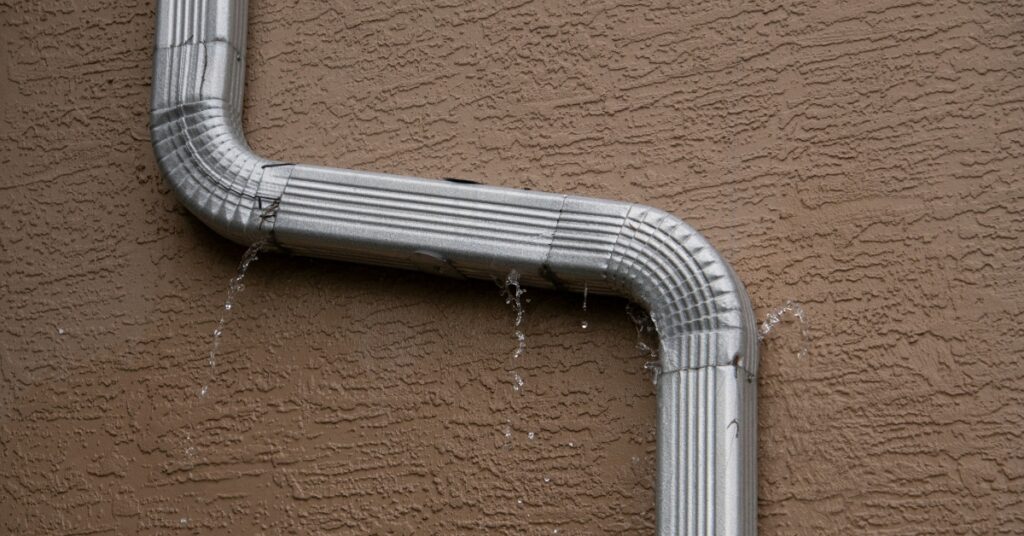When to Replace Gutters: 6 Key Signs

Table of Contents
Gutters play a critical role in protecting your home from water damage. When working properly, they carry rainwater safely away from your roof, siding, and foundation. But when they are not working properly, the results can be costly, ranging from rotting fascia boards to foundation damage, leaks, and damaged landscaping. Many homeowners ask us how to know when to replace gutters instead of simply cleaning or patching them. The answer lies in recognizing the key warning signs.
Here are six of the most common signs gutters need replacement, along with why they matter for your home.
1. Splits, Cracks, or Separated Gutters
Even small cracks in gutters can quickly turn into big problems. Over time, those splits allow water to leak through instead of flowing to the downspouts. What may look like minor wear actually undermines the entire system by letting water seep into fascia boards, siding, and even the foundation. If your gutters are showing visible cracks or seams that are pulling apart, it’s a clear indicator that replacement is the smarter option.
2. Gutters Pulling Away From the Roof or Sagging
One of the easiest problems to spot is gutters that are sagging or pulling away from the roofline. When this happens, it usually means the fasteners are failing – or worse, the fascia boards they attach to are rotting. Sagging gutters don’t channel water effectively, which leads to overflow, leaks, and structural strain. In some cases, the weight of standing water inside clogged or damaged gutters accelerates this problem, causing fascia boards to deteriorate further.
Once gutters lose their pitch or detach from the roofline, repair is rarely enough. Replacement ensures water flows correctly and your roofline stays protected.
3. Rust or Peeling Paint
If you notice sections of your gutters with rust spots, bubbling paint, or peeling finishes, it’s a sign that water has been sitting where it shouldn’t – otherwise rust would have never had the time to form. Rust eats through metal gutters, creating leaks and weak spots, while peeling paint shows the protective coating has failed. Both issues signal that gutters are no longer holding up to the weather. While touch-up paint may temporarily hide cosmetic damage, once rust has set in, replacement is the only way to restore reliability.
4. Pooling Water or Dirt Channels
Gutters are designed to direct water away from your home, not let it collect where it can cause damage. If you see pools of water near the foundation or dirt channels cutting through your landscaping from where water travels during rain, your gutters aren’t doing their job. This often happens when gutters sag, clog, or are undersized for the amount of rainfall. The damage isn’t limited to soil erosion, either. Standing water near the home can weaken the foundation over time. When gutters fail to move water safely away, replacement is the best way to restore proper drainage and protect your property.
5. Frequent Clogs and Overflow
If your gutters overflow every time it rains, even after they have been cleaned, it may be a sign that they need more than just maintenance. Persistent clogs can point to gutters that are too shallow, improperly pitched, or damaged in ways that prevent water from flowing smoothly. Overflowing water can damage siding, stain brick, and wear down walkways and landscaping. While gutter guards can help reduce debris buildup, chronic overflow is usually a symptom that it’s time for new gutters designed to handle your home’s runoff needs.
6. Mold, Mildew, or Rot Around the Roofline
Moisture is one of the biggest threats to a home’s exterior, and failing gutters often leave their mark in the form of mold, mildew, or rot. If you see black streaks on siding, mildew stains on soffits, or fascia boards beginning to soften and decay, chances are water is lingering where it shouldn’t. These issues can affect curb appeal and can lead to costly repairs if left unchecked. Replacing damaged gutters eliminates the source of excess moisture and helps preserve the structural integrity of your roofline and exterior.
Why Replacing Gutters Is Worth It
Knowing when to replace gutters comes down to protecting your home from much larger problems. Water damage to the roof, siding, and foundation is far more expensive than investing in new gutters. Modern seamless gutters, when professionally installed, not only prevent leaks and clogs but also improve your home’s appearance and long-term value.
Benefits of Gutter Replacement
If you’ve been experiencing problems with your current gutters, upgrading to a new system offers more than just a quick fix. Replacement gutters are designed to handle water more effectively, reduce ongoing maintenance, and protect your home from the long-term effects of moisture damage. By investing in new gutters, you’re not just solving today’s issues – you’re preventing tomorrow’s costly repairs.
Protects Your Foundation – New gutters direct water away from the base of your home, reducing the risk of cracks, settling, and basement leaks.
Prevents Exterior Damage – By keeping water off siding, fascia, and soffits, replacement gutters help prevent rot, mold, and peeling paint.
Improves Drainage – Modern seamless gutters handle heavy rainfall more efficiently, reducing clogs, overflow, and erosion around your property.
Boosts Curb Appeal & Home Value – Fresh, seamless gutters provide a clean, polished look that enhances your home’s exterior appearance and makes it more desirable to potential buyers.
Long-Term Savings – Investing in new gutters reduces the risk of costly repairs to roofing, siding, landscaping, and foundations down the road.
At Wallcraft Exterior Solutions, we’ve helped homeowners across Metro Atlanta and North Florida replace failing gutters with systems built to handle our region’s heavy rainfall and humidity. If you’ve noticed any of these signs, don’t wait until the next storm exposes hidden damage.
FAQ About When to Replace Gutters
Cracks, sagging gutters, rust, pooling water, frequent clogs, and mold or rot near the roofline are the most reliable signs.
Small issues like loose fasteners may be repairable, but once gutters show multiple signs of failure, replacement is more cost-effective and reliable.
Most gutters last about 20 years, depending on material, climate, and maintenance. In humid areas like Metro Atlanta and North Florida, lifespan can be shorter.
Yes. New gutters improve curb appeal and protect against water damage, both of which buyers value highly.
